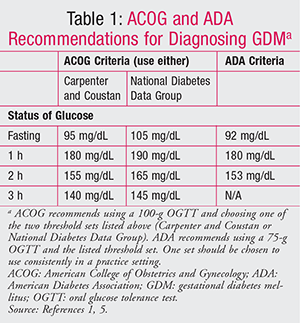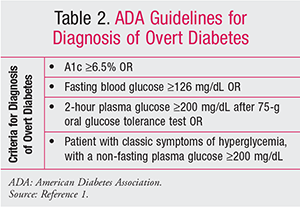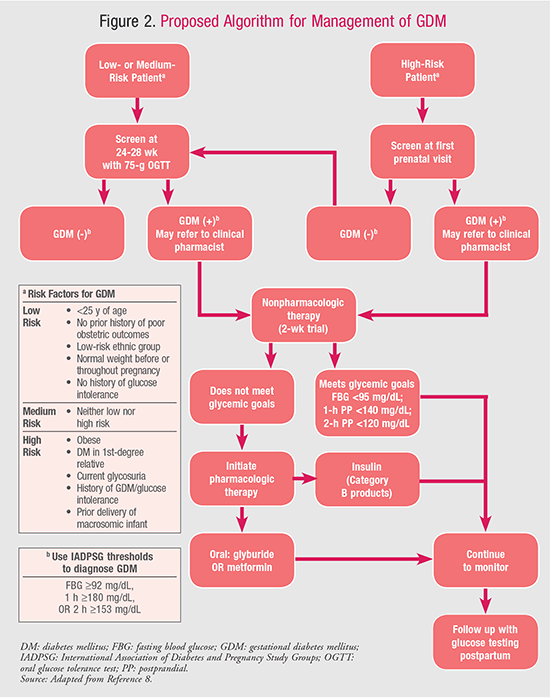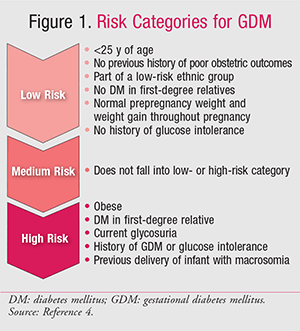ABSTRACT: Clinical pharmacists can play a vital role on a multidisciplinary team and assist with the management of patients with gestational diabetes. In this innovative practice model, implemented in a community health center working toward the designation of a patient-centered medical home, pharmacists collaborate with women’s health providers to educate patients and manage gestational diabetes. Pharmacists have the opportunity to contribute medication expertise in making pharmacotherapeutic decisions. By collaborating with the clinicians providing obstetric care, pharmacists can offer education on lifestyle modifications, self-monitoring of blood glucose, and drug therapy.
Gestational diabetes mellitus (GDM) is defined as diabetes that first presents during pregnancy.1 It is estimated that the national prevalence of GDM ranges from 2% to 10%.2 However, in states such as Texas the rates have been steadily increasing over the past few years. Data from the Pregnancy and Risk Assessment Monitoring System (PRAMS) for Texas have shown that from 2004 to 2009, the prevalence of gestational diabetes increased from 9.2% to 11.5%.3 This article will review the risk factors for and diagnosis of GDM, discuss the challenges inherent in caring for women with this condition, and describe the experience of the authors in a community health center in Texas that is initiating a team approach to caring for women with GDM in a patient-centered medical home, a process that is still evolving.
Gestational Diabetes Mellitus
Risk factors for gestational diabetes include age, ethnic group, a history of deliveries with complications, and a history of glucose intolerance.4 Women at high risk for developing GDM (Figure 1) are those who are obese, have a history of diabetes in a first-degree relative, have glycosuria, have a history of GDM or glucose intolerance in previous pregnancies, and have previously delivered a macrosomic (birth weight >4,000 g) infant. A patient is considered to be at low risk of developing gestational diabetes if she is <25 years old, is part of a low-risk ethnic group, has no family history of diabetes among first-degree relatives, has no prior history of complicated pregnancy, is of normal weight prepregnancy and throughout the course of the pregnancy, and has no prior history of glucose intolerance. Ethnic groups with the highest risk of developing gestational diabetes include persons of Native American, Hispanic, and Asian descent. African American women are considered of medium risk, and non-Hispanic white women are at the lowest risk.4
Screening and diagnostic practices for gestational diabetes vary. The American Congress of Obstetricians and Gynecologists (ACOG) recommends screening with a 50-g, 1-hour glucose tolerance test.5 Blood glucose values of either 130 or 140 mg/dL warrant further testing with a 100-g, 3-hour oral glucose tolerance test. For a positive diagnosis to be made, the patient must have at least two values that exceed the thresholds listed in Table 1. The National Diabetes Data Group and Carpenter and Coustan have established two different sets of diagnostic thresholds for GDM. ACOG does not recommend the use of one set of thresholds over another, but rather, advises choosing one set to be used consistently within a practice setting.

The American Diabetes Association (ADA) follows recommendations from the International Association of Diabetes and Pregnancy Study Groups (IADPSG).6 (This is also the guideline for diagnosis used in this community health practice setting.) At the patient’s first prenatal visit, a nonfasting blood glucose or HbA1c is performed. Based on these results, a patient may be diagnosed with overt diabetes (Table 2). If a positive diagnosis is not made, patients are screened at 24 to 28 weeks gestation with a 2-hour, 75-g oral glucose tolerance test.1 Screening for GDM is recommended at this gestational stage because of increasing insulin resistance, which is more pronounced in the second trimester. If, at 24-28 weeks of gestation, a woman’s blood glucose exceeds any one of the thresholds listed in Table 1, this is positive for a diagnosis of GDM.

For the treatment of GDM, both ACOG and ADA recommend beginning with lifestyle modifications including dietary changes and increased physical activity as tolerated.4, 5 While insulin has been the drug of choice for managing gestational diabetes for years, there is not much specific guidance available as to which product is the first-line choice and what the appropriate dosing parameters are. Both ACOG and ADA acknowledge that glyburide and metformin have been used for gestational diabetes with safety and efficacy similar to insulin's. The most recent practice bulletin from ACOG states that both insulin and oral medications are equivalent in efficacy and that either may be considered first-line in the management of GDM.5
Women who have GDM are at risk for developing it again in subsequent pregnancies, and also developing type 2 diabetes mellitus later in life. For this reason, postdelivery follow-up is important. Women should be given a 2-hour, 75-g oral glucose tolerance test again 6 to 12 weeks after delivery in order to test for overt diabetes. If a diagnosis is not made at this point, women should be tested every 3 years thereafter.5
Approach to Treatment in a Community Health Center
The practice experience discussed here focuses on a local community health center where clinical pharmacists have been working toward developing services for women with GDM. Between 2011 and 2012, the period discussed in this article, the PGY-1 pharmacy resident worked closely with other medical providers in the clinic to expand the role of the pharmacist in the management of GDM. This site is a federally qualified community health center located along the United States–Mexico border. A variety of services are provided by the clinic including family medicine, women’s health, pediatrics, dentistry, health education, and clinical pharmacy services; a dispensing pharmacy is also located on-site. The clinic serves a predominantly uninsured, underserved, Spanish-speaking population. Not surprisingly, the rate of GDM in this population is high, given the elevated risk in women of Hispanic descent.
In this practice setting, women receive prenatal care on-site from either a women’s health nurse practitioner-doctor of nursing practice (WH-DNP), a certified nurse midwife (CNM), and/or a physician. Through the patient-centered medical home model employed in the clinic, the clinical pharmacists have recently established a collaborative relationship that has been effective in managing GDM patients. The patient-centered medical model aims to provide comprehensive, coordinated care that is easily accessible to the patient and maintains a standard of quality and safety.7
Once a patient is diagnosed with GDM, the provider may choose to refer her to a clinical pharmacist; in this setting, clinical pharmacists also happen to be certified diabetes educators. At these visits, the pharmacist provides education on self-monitoring of blood glucose (SMBG) and the importance of tracking and recording these numbers. Other information provided to the patient may include sample meal plans and recommendations for exercise. Ideally, the patient follows up weekly with her SMBG log and a food diary. If blood glucose goals are not met within a certain period of time (usually 2 weeks), the clinical pharmacist will consult with the women’s health provider to initiate pharmacotherapy. The pharmacist and the clinician collaborate weekly to identify the best course of action for each individual patient. The women’s health provider brings experience and knowledge of GDM patients, and the pharmacist contributes drug expertise in choosing the appropriate action for pharmacotherapy. For instance, a pharmacist may help to decide whether it is best to proceed with insulin versus oral therapy.
Challenges Faced
Prior to implementing the patient-centered medical home model with a clinical pharmacist, pregnant patients diagnosed with GDM at this community setting were sent to the county hospital for follow-up and continuation of prenatal care. Referring patients to an outside entity was problematic because patients lost their postpartum follow-up care in their original medical home. The medical home discussed in this experience has a team of healthcare providers who are culturally and linguistically trained to work with this unique population. Within this medical home, the staff is able to continue to track and coordinate patient care over time to help improve health outcomes and reduce the risk of health disparities. The clinic employs an electronic medical record to document all patient encounters, as well as track laboratory results, referrals, current medications, and the like. Within this system, providers are also able to flag and refer patients to other providers within the clinic. In the case of GDM patients, the women’s health provider will complete an in-house referral for the patient to be seen by the clinical pharmacist.
Despite the extensive support provided by clinicians and staff at this clinic, several challenges exist with the in-house referral process. This clinic has a physician board-certified in obstetrics (OB) who has been contracted to provide oversight for high-risk patients (such as those with GDM). The OB is also the physician of record for both the WH-DNP and the CNM. This arrangement can be difficult when coordinating care. The overseeing physician is present only once a week and works closely with the women’s health providers previously mentioned. Because the overseeing physician is from the county hospital, high-risk patients will often be referred to its services. Since the recent collaboration between the pharmacist and women’s health providers, patients who do not require insulin therapy have remained in-house and have been followed up by clinical pharmacists for the monitoring of blood glucose levels, management of oral agents, and basic medical nutrition therapy counseling. These patients are thus able to continue care within their own medical home, rather than switching care to the county hospital.
The lack of consistent evidence-based guidelines for management of GDM is another barrier to expanding this community health center’s clinical services in this area. Neither ACOG nor ADA has provided detailed clinical practice guidelines that can be utilized for the management of GDM patients. There are different trials using various treatment approaches that can be used to guide clinical practice. Ultimately, experience will guide and affect how a provider will make a decision. Some providers prefer and are comfortable with oral agents versus insulin and vice versa in the management of GDM. Based on this comfort issue, it is important to educate all providers and staff on the risks and benefits associated with both oral agents and insulin, if needed, for their patients. This requires ongoing in-service training and support from all members involved.
Opportunities for Improvement
As of 2012, steps were being discussed to keep all patients diagnosed with GDM at the clinic, instead of referring them to external providers. This would require greater collaboration between the clinical pharmacist team and women’s health provider team (including the WH-DNP, the CNM, and the OB physician). Since collaboration with clinical pharmacists began, improvement has been made in providing culturally appropriate services to these patients in meal planning, prepregnancy planning, and managing GDM with oral medications or insulin. Discussion of implementing a protocol/algorithm detailing the use of insulin or oral agents for GDM patients was pending the approval of the overseeing physician. Positive conversations had occurred concerning patients who require insulin and the possibility of keeping them at the health center as long as a detailed protocol (to be based on Figure 2) is in place.8 This protocol would take into consideration several recent studies and evidence-based recommendations that include populations similar to the populations served at this clinical setting.

Progress Report
As of 2014, providers in the clinic have continued to work toward expanding the role of the pharmacist in the management of GDM. Clinical pharmacists continue to comanage GDM patients. Based on the complexity of the patient, the intervals in which she is seen for follow-up may vary. A specific protocol for GDM management has not yet been implemented, but the pharmacists do practice under a collaborative practice agreement. This agreement allows pharmacists to initiate oral medications as appropriate. The pharmacists use the algorithm presented in Figure 2 as a general guide for the treatment of GDM, along with other recent publications that give guidance on the use and titration of oral medications for GDM.9,10 Ideally, with the approval of the OB physician, the pharmacists will be able to create a more specific protocol that could be used to help guide dosing of both insulin and oral medications. One barrier the health care team continues to face is the management of those GDM patients who require insulin therapy. These patients are still being sent out to the county hospital for prenatal care. In the future, the women’s health team would like to keep all GDM patients, including those being managed with insulin, within this facility.
The collaboration between the women’s health department and the clinical pharmacy team is expected to help provide, expand, and enhance current services to women who are at most risk for health disparities, and provide culturally competent healthcare to help improve the poor health outcomes that often affect minority groups.
Conclusion
GDM is a complication of pregnancy that can affect both mother and child throughout pregnancy and childbirth, as well as later in life. This condition requires a certain level of expertise, knowledge, and experience to manage. The practice experience discussed here demonstrates the importance of collaboration between pharmacists and women’s health providers when managing high-risk patients. This collaboration allows patients the option to remain in their original medical home. Providers and pharmacists are able to continue to provide services that are culturally and linguistically appropriate throughout each stage of pregnancy and follow-up.
The pharmacist is an important team member who contributes to the management of gestational diabetes through knowledge of pharmacotherapy and experience in medication management. The relationship established between the providers, pharmacist, and patients aligns well with the patient-centered medical home model.
Acknowledgement: Centro San Vicente Family Health Center, El Paso, Texas. During 2011-1012, the first author was a PGY-1 Community Pharmacy Practice Resident, UTEP/UT Austin Cooperative Pharmacy Program.
REFERENCES
1. American Diabetes Association. Standards of medical care in diabetes—2014. Diabetes Care. 2014;35:S14-S80.
2. Centers for Disease Control and Prevention. 2011 National diabetes fact sheet. www.cdc.gov/diabetes/pubs/estimates11.htm#8. Accessed December 29, 2011.
3. Texas Department of State Health Services. Prevalence and outcomes of pre-existing and gestational diabetes, 2004-2009 Texas Pregnancy Risk Assessment Monitoring System (PRAMS). www.dshs.state.tx.us/diabetes/PDF/newsletter/spring11.pdf. Accessed January 11, 2012.
4. Perkins JM, Dunn JP, Jagasia SM. Perspectives in gestational diabetes mellitus: a review of screening, diagnosis, and treatment. Clinical Diabetes. 2007;25:57-62.
5. American College of Obstetricians and Gynecologists. Gestational Diabetes. ACOG Practice Bulletin 137. Washington, DC: ACOG; 2013.
6. International Association of Diabetes and Pregnancy Study Groups Consensus Panel. International Association of Diabetes and Pregnancy Study Groups recommendations on the diagnosis and classification of hyperglycemia in pregnancy. Diabetes Care. 2010;33:676-682.
7. Agency for Healthcare Research and Quality. Patient Centered Medical Home Resource Center. Defining the PCMH.. http://pcmh.ahrq.gov/page/defining-pcmh. Accessed August 20, 2014.
8. Jacobs TF, Tyrell JM. Management of gestational diabetes. US Pharm. 2011;36(5)(Diabetes suppl):3-6.
9. Zeng Y, Mu-Jun Li Y, Li Jiang S. The use of glyburide in the management of gestational diabetes mellitus: a meta-analysis. Adv Med Sci. 2014:59:95-101.
10. Tempe A, Mayanglambam R. Glyburide as treatment option for gestational diabetes mellitus. J Obstet Gynaecol Res. 2013;39:1147-1152.
To comment on this article, contact rdavidson@uspharmacist.com.






